Pennsylvania is home to numerous bird species, including birds of prey such as hawks. Whether you’re a resident of the state, a bird enthusiast, or just curious, you may be wondering what types of hawks live in Pennsylvania. The state boasts expansive natural areas where hawks can freely nest, breed, and hunt.

Watching a hawk hovering in the sky is captivating, especially if you get the chance to watch one diving for prey. If you look in the right areas, it’s always possible to find at least one hawk within the state. Furthermore, several national and state parks are perfect for birdwatching in Pennsylvania.
Here is a list of 9 types of hawks in Pennsylvania.
1. Red-tailed Hawk
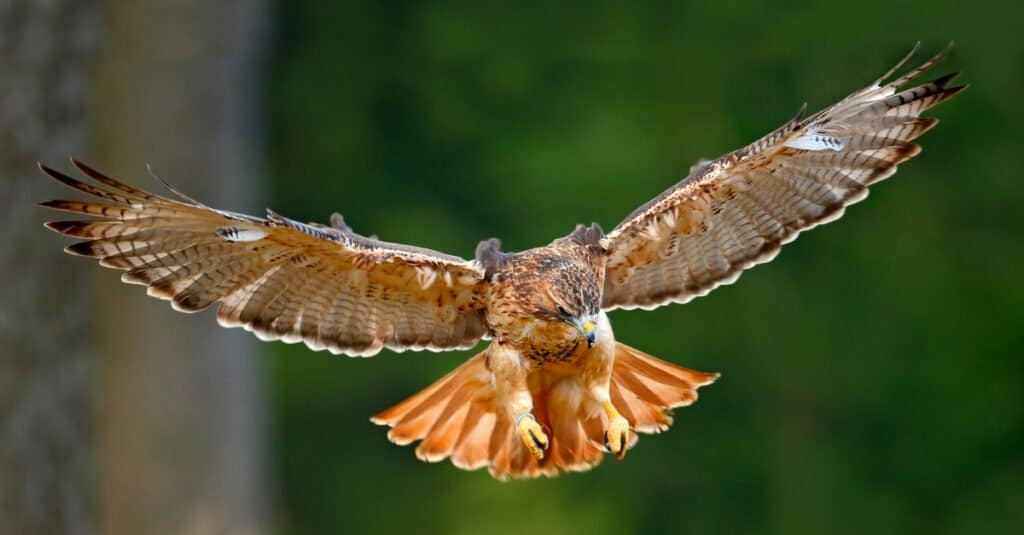
Red-tailed hawks feed on lizards, rabbits, rodents, and small animals.
©Ondrej Prosicky/Shutterstock.com
| Red-tailed Hawk | |
|---|---|
| Scientific name | Buteo jamaicensis |
| Weight | 1.5-3.5 lbs (680-1586 g) |
| Height | 18-26 in (45-65 cm) |
| Wingspan | 43-56 in (110-141 cm) |
Red-tailed hawks are very common in Pennsylvania. They are often spotted in tall perches trying to catch sight of prey in the open spaces next to highways. They can spot a mouse from as far as 30 meters while soaring and circling high up in the sky. These hawks have a brick-red tail, from which their name was derived.
Red-tailed hawks feed on lizards, rabbits, rodents, and small animals. Upon spotting prey, the red-tailed hawk swoops down at a very high speed and grabs its meal using its talons.
Red-tailed hawks are very secretive nesters who prefer living in dense hardwood forests away from their potential predators like humans, great-horned owls, and bobcats. The female red-tailed hawk lays between 1-5 whitish, brown-spotted eggs. Both male and female red-tailed hawks take turns incubating the eggs. Young ones leave the nest when they are around six weeks old.
2. Broad-winged Hawk
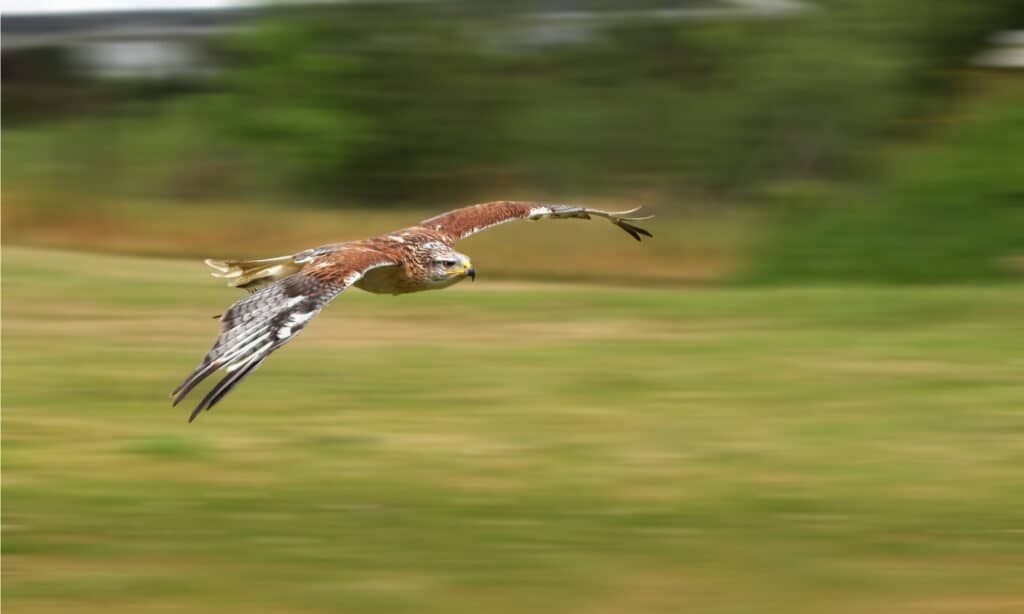
Broad-winged hawks have a diet that consists of crabs, frogs, snakes, lizards, voles, shrews, and other small birds.
©pr2is/Shutterstock.com
| Broad-winged Hawk | |
|---|---|
| Scientific name | Buteo platypterus |
| Weight | 9.3-19.8 oz (264-561 g) |
| Height | 13.4-17.3 in (34-44 cm) |
| Wingspan | 31.9-39.4 in (81-100cm) |
Broad-winged hawks are not often spotted in Pennsylvania. Still, they breed within the state before migrating to South America in a swirling flock best known as “kettles.” These hawks dwell in the deepest ends of the forests, making it hard to be seen during nesting season. They dread nesting close to human dwellings.
Broad-winged hawks are small and stocky. Adults have a pale underneath and a dark brown back with a dark gray to black tail. They also have broad wings, just as their name suggests. Young broad-winged hawks are whiter on their belly and chest compared to their parents.
Broad-winged hawks have a diet that changes with the seasons. They eat what is available, but their diet consists of crabs, frogs, snakes, lizards, voles, shrews, and other small birds. However, these hawks are also susceptible to predation by great-horned owls, black bears, porcupines, and raccoons.
Both males and females participate in nest building just before the brooding season. The female lays 1-4 bluish, whitish, or pale cream eggs. The female also takes care of the eggs until they hatch, which takes about a month.
3. Northern Goshawk

Northern goshawks build their nests in the crotches of deciduous trees in mixed forests.
©Milan Zygmunt/Shutterstock.com
| Northern Goshawk | |
|---|---|
| Scientific name | Accipiter gentilis |
| Weight | 1.4-4.8 lbs (635-2177 g) |
| Height | 18-27 in (46-69 cm) |
| Wingspan | 40-46 in (103-117 cm) |
Northern goshawks are found in the most remote, higher-elevation forests in Pennsylvania. They are very secretive birds, so they can be hard to find within the state. They are gray with long tails and broad wings.
Northern goshawks are generally bigger and more aggressive than other hawks, like sharp-shinned hawks. Their diet consists of snowshoe hares, rabbits, squirrels, crows, and other small mammals. They fly low through woods in search of prey or may opt to perch quietly in trees while listening and watching for prey.
Northern goshawks build their nests in the crotches of deciduous trees in mixed forests. Females lay 2-4 whitish, blue eggs. Males provide food as the female incubates the eggs, which may take up to 32-38 days to hatch.
4. Rough-legged Hawk
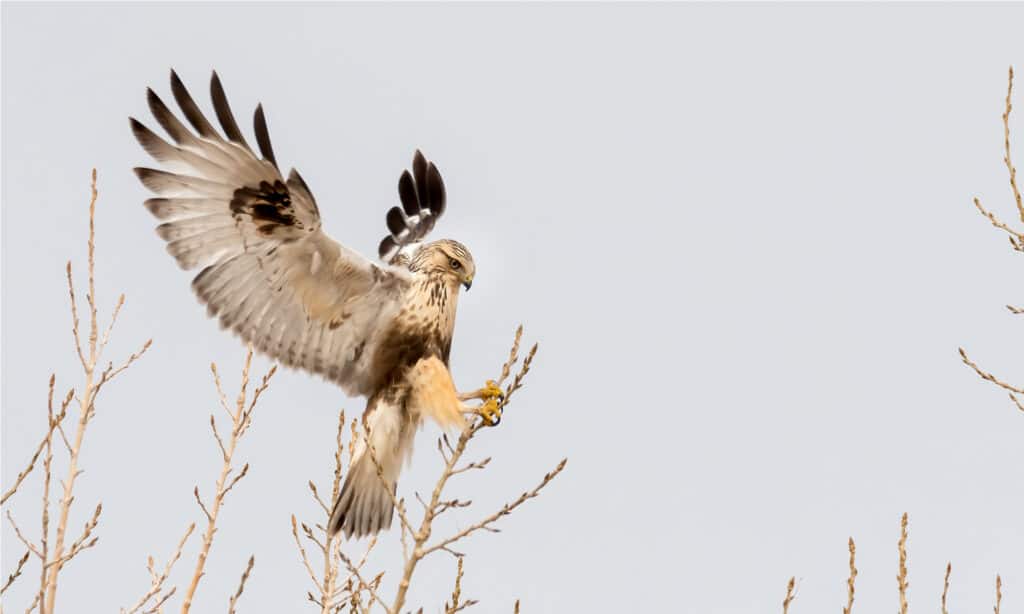
Rough-legged hawks feed on voles, shrews, mice, rabbits, and ground squirrels.
©Eivor Kuchta/Shutterstock.com
| Rough-legged Hawk | |
|---|---|
| Scientific name | Buteo lagopus |
| Weight | 1.32-3.66 lbs (599-1660 g) |
| Height | 18-24 in (46-60 cm) |
| Wingspan | 52-54 in (132-138 cm) |
Rough-legged hawks are medium-sized birds of prey with wider wings. They are usually spotted in open fields and marshes. They are dark brown and boldly patterned, with dark tail tips. These hawks often hover against the wind while hunting.
Rough-legged hawks feed on voles, shrews, mice, rabbits, and ground squirrels. Raptors such as eagles and other large falcons prey on rough-legged hawks of almost all ages.
These hawks prefer breeding in the Arctic and migrate in winter to more open areas. You can easily spot them in Pennsylvania in winter while they are hovering around in deserts, prairies, or open fields. Females lay between 3-5 pale-bluish white eggs.
5. Swainson’s Hawk
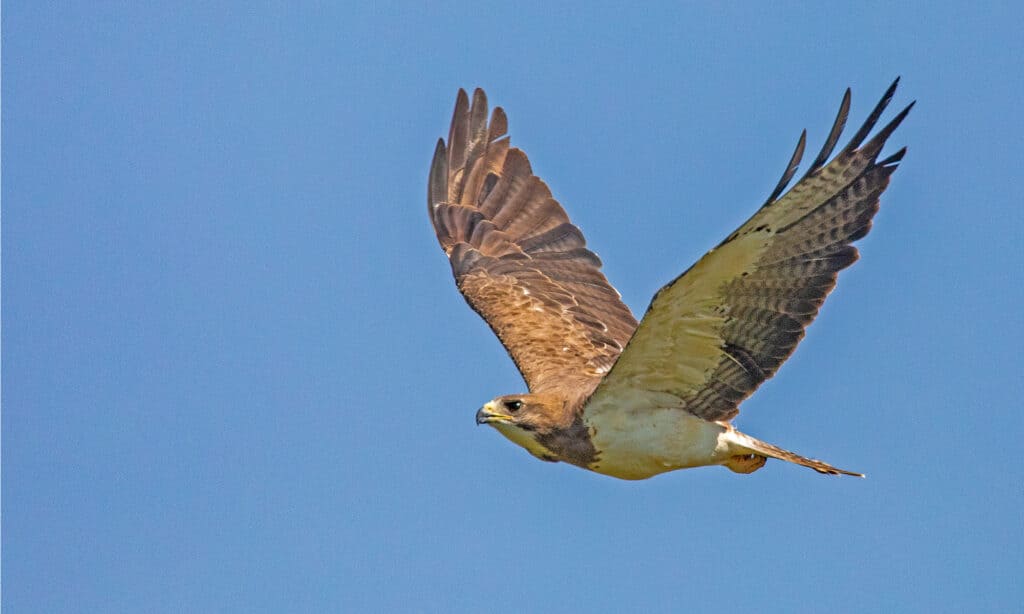
Swainson’s hawks mainly inhabit the grasslands in summer before migrating in fall.
©Lowell Monke/Shutterstock.com
| Swainson’s Hawk | |
|---|---|
| Scientific name | Buteo swainsoni |
| Weight | 1.1–3.7 lbs (499-1678 g) |
| Height | 17-22 in (43-56 cm) |
| Wingspan | 46-54 in (117–137 cm) |
Swainson’s hawks are often sighted in large groups in Pennsylvania throughout the year. Unlike all the other hawks, Swainson’s hawks are very social birds of prey who spend most of their time perched up in isolated trees, fence posts, and utility wires near human dwellings. They migrate to Argentine wintering grounds during fall. It’s one of the longest migrations with the most stunning views of thousands of Swainson’s hawks high up in the sky.
Swainson’s hawks mainly feed on crickets, grasshoppers, and other animals they catch midair or hunt on the ground. They don’t eat other birds but rather live harmoniously with each other.
Swainson’s hawks mainly inhabit the grasslands in summer before migrating in fall. Females lay 1-5 eggs that take around 34-35 days to hatch.
6. Red-shouldered Hawk
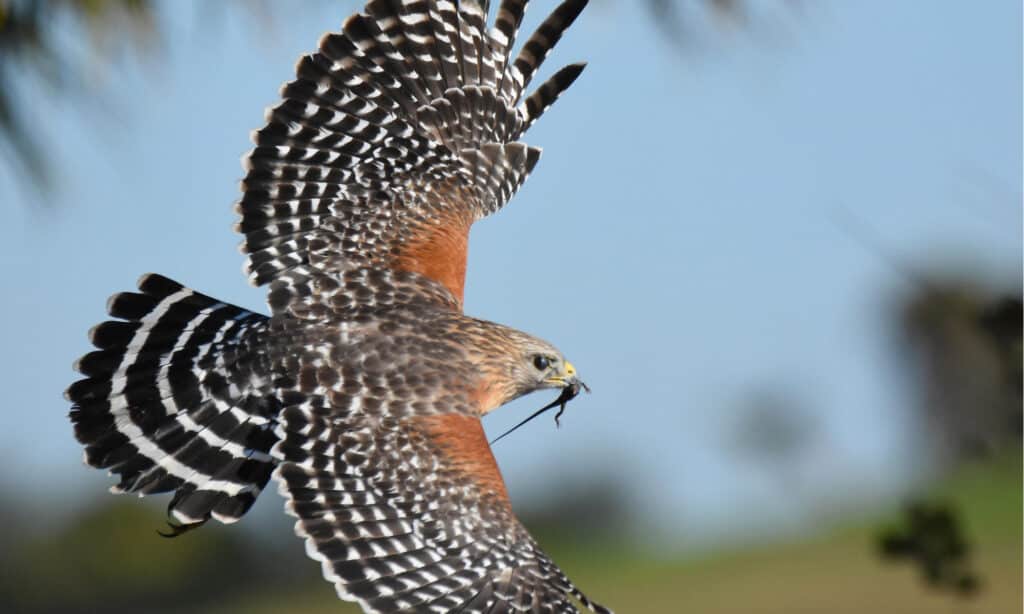
Red-shouldered hawks often reuse their nests built in deciduous forests near swamps and rivers.
©MTKhaled mahmud/Shutterstock.com
| Red-shouldered Hawk | |
|---|---|
| Scientific name | Buteo lineatus |
| Weight | 1-1.7 lbs (486-774 g) |
| Height | 15-24 in (38-61 cm) |
| Wingspan | 35-50 in (90-127 cm) |
Red-shouldered hawks are often sighted in Pennsylvania year-round, hovering over swamp forests and riverine parks. Technically, they are associated with tall trees and water. They prey mainly on mice, snakes, and frogs.
Red-shouldered hawks have distinctive reddish barring on their breasts and a strongly banded tail. They also have dark-white checkered wings. Immature red-shouldered hawks are brown on top and white underneath.
Red-shouldered hawks often reuse their nests built in deciduous forests near swamps and rivers. Females lay between 2-5 whitish or bluish eggs.
7. Sharp-shinned Hawk
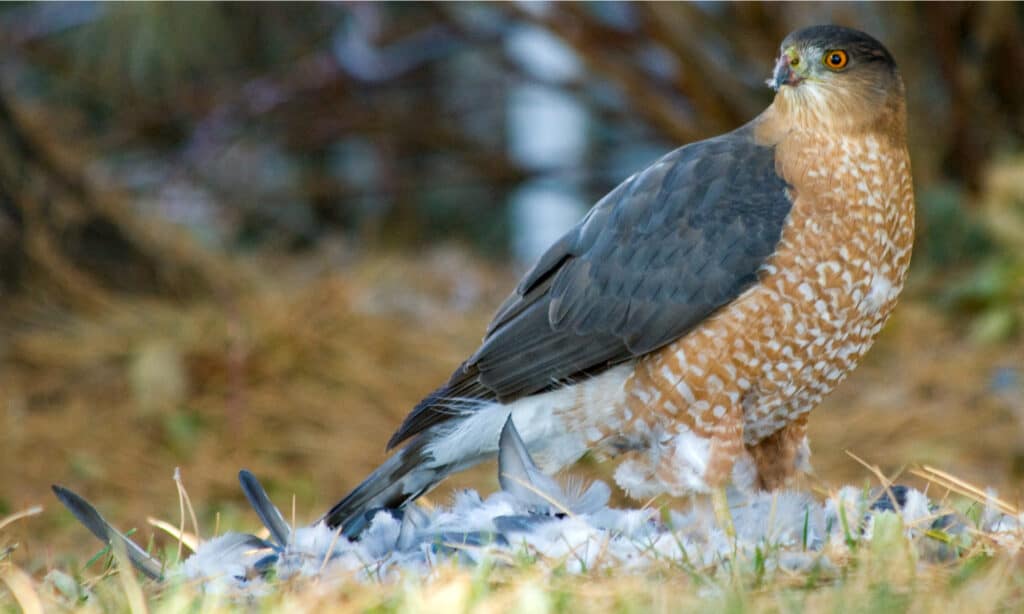
Sharp-shinned hawks are very small, long-tailed hawks with round wings.
©Wyatt W/Shutterstock.com
| Sharp-shinned Hawk | |
|---|---|
| Scientific name | Accipiter striatus |
| Weight | 2.9-7.7 oz (82-219 g) |
| Height | 9.1-15 in (23-37 cm) |
| Wingspan | 17-27 in (42-68 cm) |
Sharp-shinned hawks are very small, long-tailed hawks with round wings. They can be sighted in Pennsylvania throughout the year. They have small heads which cannot protrude beyond their wings. Adult sharp-shinned hawks are grayish-blue above and red-orange on their breasts. Their young ones are brown with broad dark bands across their long tails, just like adults.
Sharp-shinned hawks eat large insects, snakes, frogs, lizards, squirrels, bats, rodents, and mostly small birds. They speed through the dense forests to surprise prey once they spot one. They may as well pounce from low perches.
Sharp-shinned hawks live and breed in the deepest parts of the woods. They only come out during migrations and when hunting for prey along forest edges. Females lay 3-8 white or pale-blue speckled eggs.
8. Northern Harrier

Male northern harriers are gray on top and white underneath, with a unique black-banded tail.
©Harry Collins Photography/Shutterstock.com
| Northern Harrier | |
|---|---|
| Scientific name | Circus hudsonius |
| Weight | 11-27 oz (300-750 g) |
| Height | 21-25 in (53-64 cm) |
| Wingspan | 41-46 in (103-117 cm) |
Northern harriers are slender, long-tailed hawks found in Pennsylvania all year. They have a sharply hooked bill and an owl-like flattened face. They usually hover about searching for prey with their wings spread out in a V-shape.
Male northern harriers are gray on top and white underneath, with a unique black-banded tail. Females have whitish undersides with brownish specks. The young ones are brown with black tail tips.
Northern harriers mainly feed on smaller birds and mammals, but they can snatch bigger prey like ducks and rabbits. They live and breed in open places such as marshes, prairie grasslands, and Arctic tundra. Females lay between 4-5 dull white eggs.
9. Cooper’s Hawk

Cooper’s hawks generally eat squirrels, mice, bats, and medium-sized birds.
©Aussiemandias/Shutterstock.com
| Cooper’s Hawk | |
|---|---|
| Scientific name | Accipiter cooperii |
| Weight | 7.8-14.5 oz (220-410 g) |
| Height | 14-20 in (35-50 cm) |
| Wingspan | 24-39 in (62-99 cm) |
Cooper’s hawks are common woodland hawks that can be seen throughout the year in Pennsylvania. They are the most skillful fliers who never miss prey once they spot one. They are similar to sharp-shinned hawks, and both species are always sighted near bird feeders looking for an easy meal.
Cooper’s hawks generally eat squirrels, mice, bats, and medium-sized birds. They approach the prey through dense cover and pounce on them with a rapid, powerful flight.
These hawks build nests in beech, oak, pine, spruce, and many other tree species. Females lay 2-6 pale blue to bluish-white eggs.
The photo featured at the top of this post is © Jesus Giraldo Gutierrez/Shutterstock.com
Thank you for reading! Have some feedback for us? Contact the AZ Animals editorial team.






